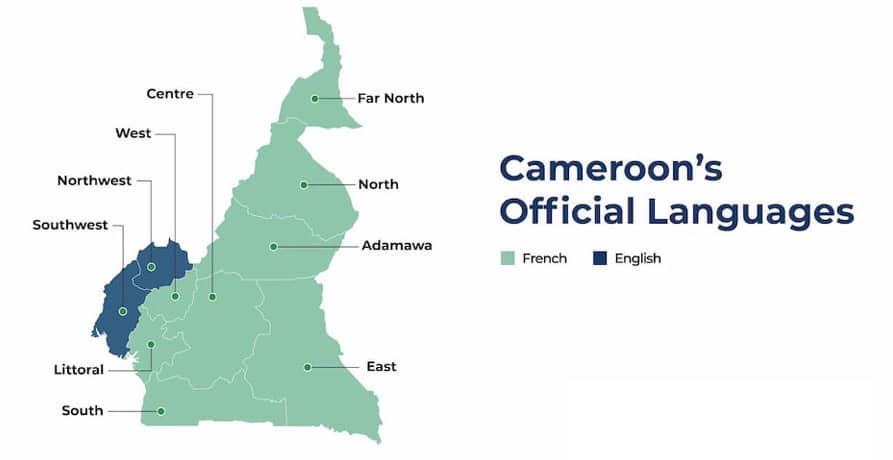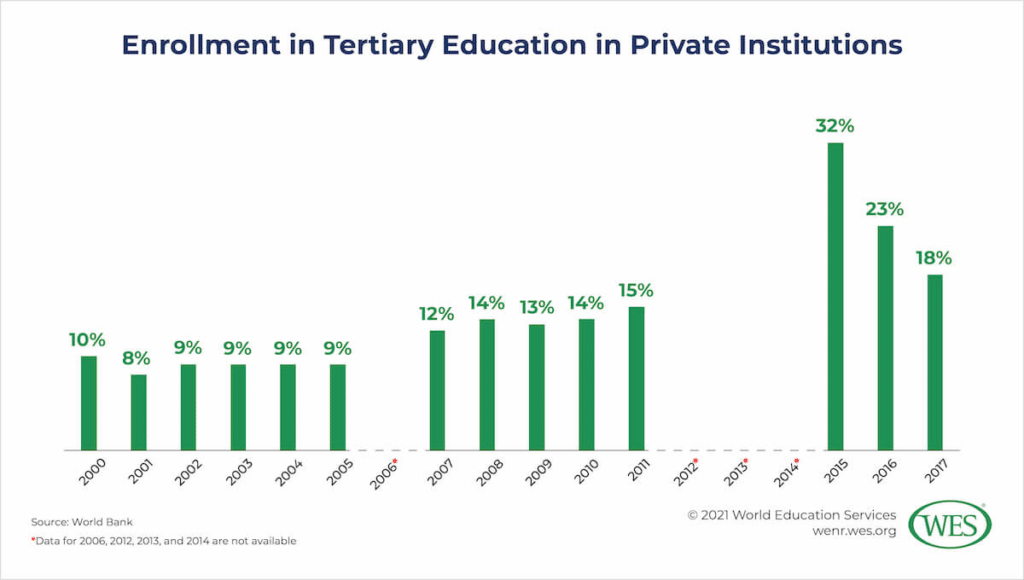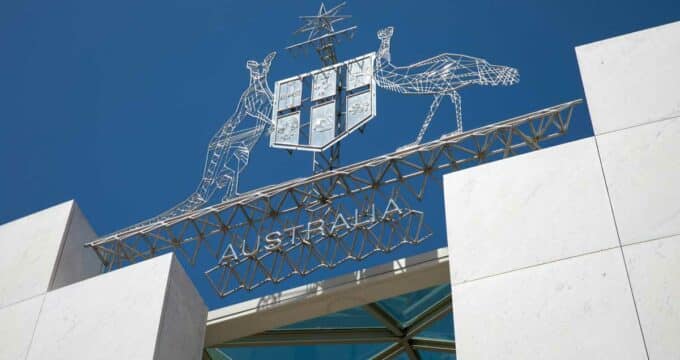Recruiting international students in Cameroon
- There is great demand for study abroad in all regions of Cameroon and from both Anglophone and Francophone students
- Recruiters are stepping up their efforts in the country, including those from Chinese institutions
FAST FACTS
Official name: Republic of Cameroon
Geography: Cameroon is in Central Africa on the Gulf of Guinea. It shares borders with Equatorial Guinea, Gabon, Nigeria, Chad, the Central African Republic, and the Republic of the Congo.
Capital: Yaoundé
Population: 30 million (2025) and rapidly growing (14th in the world).
Youth population: Over 60% of the population is under 25
Median age: 18
GDP: US$56 billion (projected 2025)
Currency: Central African Franc (CFA franc)
Official languages: English and French (but more than 24 other African languages are spoken in the country). Many Cameroonians speak an African language first, and either English or French second. The ratio of French to English proficiency is estimated at 80%–20%, and this stems back to post-WWI when the League of Nations stripped Germany of its claim on Cameroon and accorded four-fifths of Cameroon to France and one-fifth to Britain for governance.
Main language of instruction: French in some regions, English in others, and bilingual instruction in some cases. For decades, the aim has been for bilingualism throughout the country, but most Cameroonians are not functionally proficient in both languages. The language of instruction follows regional lines, echoes colonial legacies, and reflects ethnic divisions in some cases.
English proficiency: “Very low” according to the EF Proficiency Index.
Religion: Christianity is predominant, but Islam is followed by 30%.
Outbound students: About 30,000. Cameroon is the second largest African sender of students abroad after Nigeria.
Main student cities: Yaoundé, Douala, Buea, and Bamenda.
Main destination countries for Cameroonian students: France, Canada, Germany, China, Morocco, Tunisia, South Africa.
The Republic of Cameroon is one of the few countries in the world containing significant demand for both French and English higher education programmes. The country’s development is highly influenced by German, French, and British colonial legacies and the languages associated with them.
After WWI, Cameroon’s governance was divided between France and Britain. Most of Cameroon was put under French influence, while Britain was left with about a fifth of the country in the Northwest and Southwest regions. That political and geographic division was arbitrary, and it divided cultures and ethnic groups that had once been very similar. What’s more, as a colonial power, France invested more in the economic and education systems of Cameroon relative to the British, who focused their interest on Cameroon’s larger neighbour, Nigeria.
Cameroon achieved independence in 1960, but resentment is high among English-speaking Cameroonians about the advantages their French-speaking compatriots enjoyed in colonial times and now. Francophone-majority regions are treated much more favourably by the country’s present-day, independent government.
About 25% of Cameroon’s population speaks English (close to 3 million people), while 58% (about 6.5 million) speak French. Drilling down further, roughly a fifth of English-speakers speak English and not French (but may speak African languages in addition to English), while almost half speak only French (and possibly other African languages) and not English. On average, a Cameroonian speaks three languages a day.
A bitter civil war has been ongoing for seven years, and it is often called “the Anglophone crisis” given the conflict’s roots in English-speakers’ anger about lack of economic opportunity, educational access and quality, and benevolent governance.
The Oxford Political Review explains:
“Opportunities for higher education in English are minimal. Though the University of Yaoundé is officially bilingual, a 2020 study found that 80% of lectures are conducted in French. Textbooks in English are usually poorly translated. Key laws, including systems of corporate regulations, often lack English translations. Civil servants are overwhelmingly Francophone and conduct their services in French. In 2017, out of 36 political ministers with a portfolio, only one was Anglophone. Francophone lawyers, judges, and teachers are frequently given positions in the Anglophone regions. Poverty levels in the Anglophone regions are among the highest in the country. Political discrimination is rampant. Since the 1990s, the government has issued restrictions on Anglophone advocacy groups ranging from restricting gatherings in public buildings to banning books and media examining the crisis.”
World University News and Reviews (WENR) notes that 2017 was a flash point of the tensions around language instruction in Cameroon:
“[In 2017], the Anglophone-based Cameroon Teachers Trade Union (CATTU) presented the central government with a list of grievances, including higher rates of admission of Francophone students into professional and technical schools, accusations of doctoring admissions conducted in Yaoundé for Francophone students applying to the Anglophone region’s two main universities, and the appointment of Francophone teachers lacking a command of English to Anglophone schools.
Even at the country’s two Anglophone universities, Bamenda and Buea, Francophone students outnumber Anglophone students in professional departments by a ratio of nine to one. Some university entrance examinations have even been offered exclusively in French or in poorly translated English, putting Anglophone applicants at a severe disadvantage.”
The tensions escalated to armed conflict, shuttering schools and closing off educational opportunities for Anglophone students in the Northwest and Southwest regions. Since then, some schools have reopened but educational quality for Anglophone students continues to suffer. Many Anglophone teachers have reported being forced to teach in French to English-speaking students. And students in the Northwest and Southwest regions are living amidst a violent insurgency by Anglophone separatists striving for independence from Cameroon.
Across all regions, the Cameroonian government allocates only 13% of total annual budget to education. By comparison, the education budget line is 24% of the total in Morocco.

How do language tensions influence outbound mobility from Cameroon?
There is great demand for study abroad in all regions of Cameroon and from Anglophone and Francophone students. However, Francophone students are often privy to higher quality primary and secondary education than their Anglophone counterparts, and their numbers are far greater. Because of regional economic disparities, Anglophone families are often less able to fund their children’s education abroad. Institutions recruiting Anglophone Cameroonians should have robust financial, language, and academic supports/pathways in place in order for those students to succeed.
Official data show that Cameroonians (of whom most are Francophone) currently favour the overseas destinations of France (10,880 Cameroonians in 2023/24, +11% y-o-y), Canada: 8,095 in 2023/24, +100% y-o-y), and Germany: 6,780 (+3% y-o-y). But there are many Cameroonians in other places as well, including Morocco (where 19,000 students out of a total of 23,500 international students are African), South Africa, Tunisia, and China.
Strong moves by China and Morocco
Cameroon is part of China’s Belt and Road soft power initiative, and given the economic opportunities opened by Chinese investment in their country, increasing numbers of Cameroonian students are learning Mandarin. China is also offering robust scholarships to Cameroonian students.
Morocco, too, is flexing its soft power in sub-Saharan Africa and invests the most of any African country in the Economic and Monetary Community of Central African States (CEMAC). Pierre Oyonomvogo and Sanae Kasmi, scholars at the Euromed University of Fès, note that:
“The president of the Association of Cameroonian Students in Morocco reports that there are approximately 300 Cameroonian students with scholarships, and 150 students in private universities in Morocco. To allow Cameroonian students to migrate, Morocco through the Ministry of Higher Education of Cameroon, has for years been launching a call for applications for scholarships.”
Economic growth and inequities
The UN considers Cameroon a lower-middle-income economy with “rich natural resources, including oil and gas, mineral ores, and high-value species of timber and agricultural products, such as coffee, cotton, cocoa, maize, and cassava.” These natural resources are naturally a draw for foreign investors and represent incredible potential for Cameroon’s development. The economy is projected to grow by 4.4% in 2025, an expected expansion tied to rising global commodity prices.
However, corruption is rife in the country (the 2024 Transparency International Corruption Perceptions Index ranked Cameroon 140th of 180 countries, where #1 is the least corrupt and #180 is the most) and income disparities are significant. The World Bank notes:
“Poverty reduction in Cameroon has stagnated over the past 20 years, with approximately 4 in 10 Cameroonians living below the national poverty line. The household survey data from 2021-2022 suggests that 23.0% of the population lives below the extreme international poverty line with only $2.15 per person per day, adjusted for purchasing power parity (PPP).”
The drive to emigrate is strong, and a very large proportion of Cameroonian students want to emigrate after studying abroad to increase their opportunities for decent salary and for the chance to send money home to their families. Immigration pathways are a main reason that Canada has risen steeply as a popular destination among Cameroonians up to 2023. Canada’s immigration settings have tightened since 2024 for most international students, but the Canadian government continues to encourage Francophone international students to come to the country to study and immigrate.
Cameroon is a hotly contested student market, and institutions in many destinations are offering scholarships to establish a solid presence in the country.
Higher education
Access to higher education is low in Cameroon (14% in 2018) relative to the rest of the world, but high in the context of Central Africa (where the average is closer to 9%).
Most Cameroonians who attend one of the eight domestic universities choose French-language programmes. The two Anglophone universities are the University of Buea in the Southwest, and the University of Bamenda in the Northwest.
The private sector is expanding quickly (over 200 institutions today), and as in many other emerging markets, it is doing so in response to low access to public universities. The following chart from WENR shows this rise over the years. Enrolments are surging despite higher fees at private institutions, underlining the demand for higher education in Cameroon.

For additional background, please see:
















